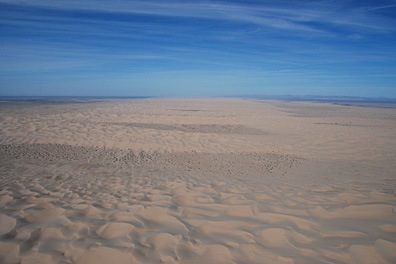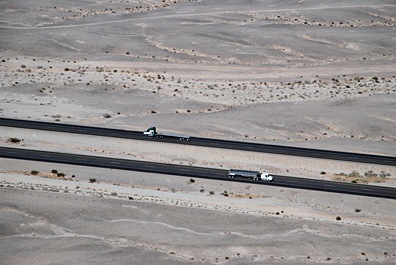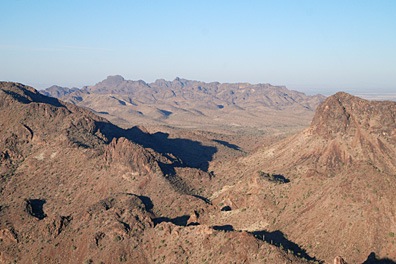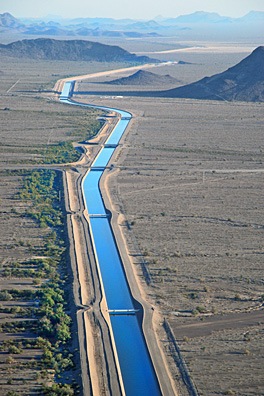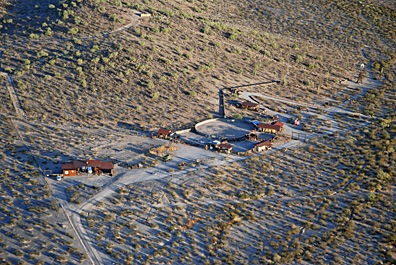When a pilot’s attitude problem leads to safety issues.
Last week, Mike and I took my brother and sister-in-law for a day trip to a popular scenic destination here in Arizona. I’m purposely being vague here to obscure the identify of the subject of this post.
 The airport we landed at has a special helicopter area that consists of a large landing pad and six parking spaces. You can see the layout in the image here, captured from Google Maps. I’ve never seen anyone use the big pad. I parked in the spot marked “My Heli.” When I touched down, all the other pads were empty, although as we walked away, an Enstrom flew in and parked at the other end of my row of pads. He was gone before we returned a few hours later.
The airport we landed at has a special helicopter area that consists of a large landing pad and six parking spaces. You can see the layout in the image here, captured from Google Maps. I’ve never seen anyone use the big pad. I parked in the spot marked “My Heli.” When I touched down, all the other pads were empty, although as we walked away, an Enstrom flew in and parked at the other end of my row of pads. He was gone before we returned a few hours later.
Some Background on the Parking “Turf War”
One of the helicopter tour operators at this destination uses the pads marked #1 and #2 in the illustration. About a year before, right after they started operating, I landed at the airport and attempted to set down in my usual parking space. A pilot was spinning on #2 and asked me to park on one of the other pads. Not knowing why — but assuming he had good reason to ask — I moved over.
I later discovered that he liked to take off through the spot where I normally parked and I was in his way. That kind of pissed me off. After all, I usually come with passengers and it’s a long enough walk to the terminal. My usual spot was the safest (pointing my tail rotor away from where people were likely to be walking) and most convenient (shorter distance to the terminal). I decided that I’d park there whenever the spot was available.
Another time when I came in for a landing, the same pilot asked me again to move over. When I said I preferred to park where I was, he said he was worried about damaging my blades as he went in and out of his spot. I didn’t say what I was thinking: how bad a pilot could he be that he couldn’t avoid another helicopter on such well-spaced pads? Instead, I told him I wasn’t worried and I used my blade tie-downs before leaving the area.
When I arrived the other day, I was glad that other pilot wasn’t around to ask me to move. Just in case he was out and about, I did tie down my blades.
An Unsafe Departure
We returned to the airport after a nice hike and walked back out to the helicopter. Now there was a tour helicopter on the pad marked #1. He’d just started up and was warming up the engine with passengers on board.
 I wanted to get some video of my helicopter sitting on the pad with the scenery behind it as a jet took off on the runway. I asked my passengers to stand by the blue X while I did this. I assumed that the helicopter on pad #1 would depart along the markings in the helipad area. That’s what we’re trained to do. That’s why there are markings there. My passengers would be well out of the pilot’s way and safe — or as safe as possible in an active helicopter landing area.
I wanted to get some video of my helicopter sitting on the pad with the scenery behind it as a jet took off on the runway. I asked my passengers to stand by the blue X while I did this. I assumed that the helicopter on pad #1 would depart along the markings in the helipad area. That’s what we’re trained to do. That’s why there are markings there. My passengers would be well out of the pilot’s way and safe — or as safe as possible in an active helicopter landing area.
I assumed wrong. The helicopter picked up to a 10-foot hover and hovered straight out toward the opposite pad, right next to mine. (See the straight green arrow in the illustration.) It was less than 15 feet from my waiting passengers as it paused at the back edge of the pad, over concrete and dirt. Dust, small pebbles, and grass clippings went flying all over us. Then the pilot took off, leaving us to brush debris out of our hair and clothing.
I was angry. The pilot’s departure was unsafe. Not only did his unusually high hover put his own passengers at risk in the even of an engine failure, but his proximity to us was downright dangerous. There was no reason for his departure route. He could have more safely departed across pad #2 (which was empty) or behind (above in the image) pad #2.
My husband, Mike, who is also a helicopter pilot, commented on the departure immediately, calling the pilot an asshole. I couldn’t agree more.
The other company helicopter returned from a flight and landed across from mine in pad #2. My group climbed into my helicopter and I started the engine. While warming up, the helicopter on #2 changed passengers. By this time, we had headsets on and were monitoring the radio. The pilot politely asked if I was ready to go. I told him I was still warming up and that he could depart. He picked up into a hover and hovered from the pad to the taxiway (see the bent green line in the illustration) — as I assumed the other helicopter would have done — and departed.
Teaching Me a Lesson?
I was almost ready to do my mag check when the first helicopter returned. The flight couldn’t have lasted more than 8 minutes. The pilot came in on the taxiway from the northeast and asked on the radio if the “Robbie” would hold position. (The way he said “Robbie” was definitely condescending; sit a guy in a turbine helicopter and he forgets what he learned to fly in.) I told him I would remain on the pad. As he taxied in for landing — before he even touched down– he told me that if I’d park at one of the other pads, I would be out of his way and my passengers wouldn’t get dusted.
This absolutely enraged me. This was obviously the same pilot who had told me to park elsewhere in the past. Apparently, he’d purposely hovered past my passengers — my family members — putting them at risk — to teach me a lesson. Now he was making sure I understood. He also very condescendingly added that they like to see out-of-town visitors, but it’s better if they park on one of the other pads.
Until this point, the parking situation had been a turf war between the tour operator’s pilots and the other helicopters who land and park at that airport. But with this incident, it became a serious safety issue. I got extremely rude to the pilot on the radio — I admit it — and, after telling him that I didn’t like him putting my passengers at risk, I said that I’d park “Any damn place I wanted.” He told me not to “cuss over the radio” and then tried to smooth it over by saying he was trying to be courteous. I told him he should be safe first.
Why?
The question I have after all of this is, why?
Why should a pilot care where other pilots park, as long as they’re not in his assigned space?
Why would a pilot purposely put people on the ground at risk to prove a point?
Why would a tour company hire a pilot with an attitude like this?
As you might guess, I didn’t let this go. I reported it to the FAA. I did it more to get the incident on record than to initiate any kind of action. If anyone else complains, I want my complaint to provide additional evidence of an ongoing problem.
The way I see it, each pilot represents all other pilots. When one pilot does something stupid and dangerous, he’s making all of us look bad. I work too hard to keep my own operations safe and trouble-free to tolerate this kind of bull from a pilot with an attitude problem.
What do you think about this? Use the comments link or form for this post to share your thoughts.


